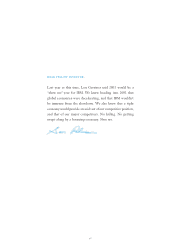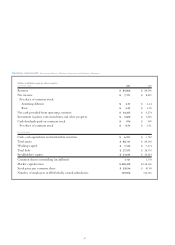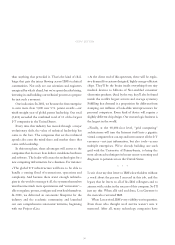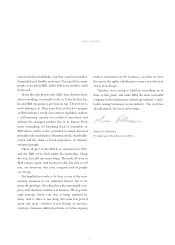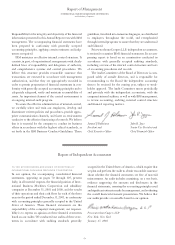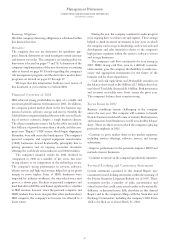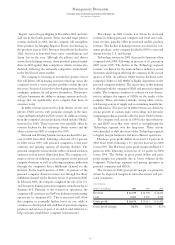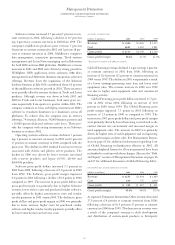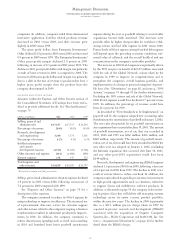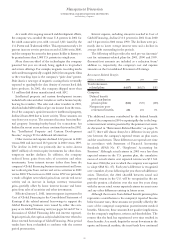IBM 2001 Annual Report Download - page 57
Download and view the complete annual report
Please find page 57 of the 2001 IBM annual report below. You can navigate through the pages in the report by either clicking on the pages listed below, or by using the keyword search tool below to find specific information within the annual report.
Road Map
The financial section of the IBM 2001 Annual Report con-
sisting of this Management Discussion, the Consolidated
Financial Statements that follow and the related notes
thereto comprises 52 pages of information. The length and
detail required by the various applicable reporting and
disclosure rules can leave a reader somewhat overwhelmed.
Therefore, this Road Map is designed to provide you with
some perspective regarding the information contained in
the financial section and a few helpful hints for reading the
next 51 pages.
IBM’S BUSINESS MODEL
The company’s business model is relatively straightforward.
IBM sells services, hardware and software. These offerings
are bolstered by IBM’s research and development capabilities.
If a customer requires financing, IBM can provide that too.
The fundamental strength of this business model is IBM’s
ability to assemble the optimal mix of these offerings to
design tailored solutions for customers and to continue to
win in the marketplace.
FINANCIAL REPORTING
IBM follows generally accepted accounting principles. It is
important for investors to understand the quality of a com-
pany’s earnings, and as you read this financial section, you
will learn about both recurring and nonrecurring events
and trends that result in items that contribute to or reduce
earnings. Some of these items and trends occur in an unpre-
dictable fashion. Among these, the following are examples
of items disclosed in this financial section:
Page
Write-downs of certain equity investments««« 62
Higher bad debt expense 61 and 91
Lower income from transfer of
intellectual property 62 and 91
Lower goodwill amortization 61
Lower interest income 62 and 91
Higher workforce accruals 61 and 91
Increase in income from retirement-
related benefits 62 and 96
Lower gains from certain real estate activity 62 and 91
Higher foreign currency transaction gains 62 and 91
It is, however, just as or more important to maintain a longer-
term perspective and to consider net income in the context
of revenues and cash flows. A fundamentally sound and
strong company should have strength in all three of these
measures. Since 1994, IBM’s business model has produced
$633 billion of revenue, $85 billion of cash flows from oper-
ations, and $49 billion of net income.
IBM does not use so-called “pro forma” earnings for its
quarterly earnings press releases or analysts conference calls.
One of the reasons that the company does not use pro forma
earnings is that many items adding to or reducing earnings
are part of the company’s operating business model. An
example of such items is transfers of intellectual property.
Although individual transactions may be large or small, the
company realizes income from such transactions every
quarter. See pages 62, 76 and 91 for additional information.
HELPFUL HINTS
Organization of Information
•This Management Discussion section is designed to pro-
vide the reader of the financial statements with a narrative
on the company’s financial results. It discusses the results of
operations for each segment of the business and is followed
by a description of the company’s financial position generally
divided between the Global Financing business and the rest.
Certain employee data is located at the end of this section.
It is useful to read the Management Discussion in conjunc-
tion with note v, “Segment Information,” on pages 100
through 105.
•Pages 70 through 74 include the Consolidated Financial
Statements. These statements include an overview of the
company’s income and cash flow performance and its finan-
cial position.
•The notes follow the financial statements. Among other
things, the notes contain the company’s accounting policies
(pages 75 through 79), detailed information on balances
within the financial statements, certain contingencies and
commitments (page 89), and the results of each IBM segment
(pages 100 through 105).
Retirement Benefits Including Pensions
Pages 62 and 63 include a discussion of the impact that
retirement benefits have on the company’s Consolidated
Financial Statements. On pages 76 and 77, you will find the
required accounting policies for these benefits. The detailed
information about each plan including financial analysis of
the larger plans is provided on pages 96 through 100.
Capital Structure
The use of debt by the company’s Global Financing business
and the importance of cash flows from operations to the rest
of the company are discussed on page 66. Page 67 continues
the discussion with an overview of the company’s total interest
expense and its relation to the Global Financing unit’s finan-
cial results. Pages 84 and 85 include detailed information
regarding the company’s debt.
Management Discussion
INTERNATIONAL BUSINESS MACHINES CORPORATION
and Subsidiary Companies
55


